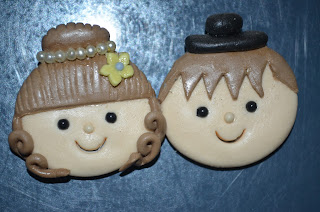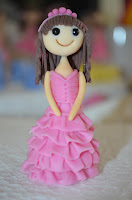Monday, November 12, 2012
Monday, October 29, 2012
Clay for Beginners
What is Clay?
Polymer Clay is an art medium that is known for its versatility, pliability and simplicity to work with. It is an oven bake modeling material composed of polymers, resins, coloring agents and fillers. Not a natural clay, it is man-made from a plastic, poly vinyl chloride (PVC) base. It is used by artists and hobbyists ranging from children to professional artists and movie makers. It stays continually soft and can be baked in a home oven, retaining its color and size. It is available in many colors, including metallic, glow-in-the-dark and "stone". It can be used to simulate many materials: stone, semi-precious stones, porcelain, wood, and glass.
What can I do with Clay?
Polymer clay can be used in an assortment of crafts, including jewelry, home decoration, pottery, scrap-booking and sculpture. Techniques for working with the clay are borrowed from glass-making, metal-working, ceramics, sculpture and textile. Clay can be used to cover anything that won't burn during firing, such as wood, frames, pens, and mirrors. To create your own colors, polymer clay can be formulated like paint, or colored with powders, chalk, ink, glitter, colored pencils, powdered makeup and paint. After baking, polymer clay can be sanded, buffed, glazed, or painted. You are limited only by your imagination, and even then, there are plenty of projects and ideas from others to choose from!
 What cautions should I take when working with clay?
What cautions should I take when working with clay?
Casual clay hobbyists can safely bake the clay in their home ovens, taking care to properly ventilate. If you are baking frequently, some artists like to use a toaster oven. Clay should not be used with anything that will prepare or touch food. Cookie sheets can be lined with foil or card-stock / index cards during baking. If you use kitchen items or toys as clay tools, be sure that these do not return to food preparation use. Washing your hands frequently and before eating is a good precaution to take. Small children should be supervised-while polymer clay is certified as nontoxic, it should not be ingested. If you have concerns about the release of fumes during baking, you can bake clay in a sealed bag, like the Reynolds baking bags, or after baking, wash the inside of the oven with baking soda and water. Always supervise children with baking.
How should Clay be stored?
Polymer Clay should be stored in its original packaging and away from heat and sunlight. Do not leave the clay in your vehicle on a hot day or it may bake. Once the packaging has been opened, it is best to store it wrapped in wax paper in an airtight container. Do not store it in Tupperware or other food storage containers that you plan to use for food in the future. A recommended place for storing clay between use is in the refrigerator or freezer, dry and away from light.
Can I paint clay?
Any of the clays can be painted, water-based acrylics applied in several, thin layers are recommended. Any paint can be used if you seal it with several layers of Sculpture glaze.
What do I need to begin?
All you really need is your imagination! Clay art can be made
with just your hands! You will also want some basic tools. Start with a
clean, smooth, cool work surface. Marble, glass, and ceramic tile are
great work surfaces. Many people like to use something that can clay can
be baked on, to minimize disruption to the clay before baking. Card-stock and index cards can be used for this purpose also. Wax paper
or parchment paper can also be used. A rolling pin, cutting blade, and
shaping tools will get you off to a great start. Some tools you may
already have at home and some you will want to buy. A pin can be used
for some detailing work and a slicing blade, like the Sculpey Super
Slicers will be a good length for caning work. A skewer or large pin
can be used for piercing to make holes for stringing projects. For more
fun and experience with the clay, you'll want to invest in a pasta
machine, measuring tools, knives, carving and sculpting tools, shape
cutters, drills, sandpaper, a clay extrude, and push-molds.
Friday, October 26, 2012
Wedding Dress
There is wedding dress in people miniature clay, hope you like it and give some comment cause i need your advise for my blog, thank you!!!!!
New Blog
hello guy there is a new page in my blog, that is cupcake clay decoration hope you like it !!!!! and don't forgot to give some comment, thank you!!!!!
Wednesday, October 24, 2012
Tuesday, October 23, 2012
Monday, October 22, 2012
History of Clay
History of Clay : Bakelite,
an early plastic used in both practical and decorative applications,
was extremely popular with designers and had an early form of polymer
clay available in kits, but the phenol base of uncured Bakelite was flammable
and these were discontinued. Modern polymer clays are based on a
plastic modeling compound brought to the attention of German doll maker
Kaethe Kruse in 1939 as a possible replacement for plastics that had
become difficult to obtain during the early days of World War II.
It was not suitable for use in her doll factory, so Kruse turned it
over to her daughter Sophie, who was known in the family as "Fifi". The
formulation was later sold to Eberhardt Faber and marketed under the
name "FIMO" (FIfi's MOdeling Compound) in honor of Sophie Rehbinder-Kruse.
Meanwhile, in the early 1940s, Zenith Products Company was founded in
Schiller Park, Illinois, USA. Zenith began as a company that
manufactured coatings for the fastener industry: waxes, hot melt
compounds, and electrical insulating varnishes. The product "Sculpey"
was originally formulated for potential use as a thermal transfer
compound - to conduct heat away from the cores of electrical
transformers. However, this formulation was not successful for that
purpose, so the compound was temporarily shelved. A visitor to the
manufacturing plant was "doodling" with a lump of the clay-like
substance and created a small figure. It was then baked in a lab testing
oven - and Sculpey
was "discovered" as a sculpture medium. This happened in the mid
1960's. By 1967, it was being manufactured and sold on a small scale in
the United States.
The history of polymer clay as an art medium is only decades long,
unlike many media that have been around for centuries and have long
traditions. This newness means that there is a great deal of innovation
by users of polymer clay. Often, ideas are born by borrowing from the
traditions of some other materials, such as metalworking (mokume-gane), ceramics, glass (millefiori, lampwork),
paper, etc. There also is extensive derivation inside the medium
itself, as the attributes of this accessible medium lend themselves to
sharing and copying.
Polymer art jewelry is now part of the permanent collections of the
Museum of Art and Design in New York, the Museum of Fine Arts in Boston,
the Philadelphia Museum of Art, the Racine Art Museum, and others.
Polymer Clay accessory making has become increasingly popular in the
younger generation especially with the new communication methods like
the internet. Online, various sites like Youtube.com have become a
nesting ground for new techniques and ideas to spread, as well as a
place for artists and hobbyists to show their creations.
Monday, October 8, 2012
Welcome
Hello guy's welcome to my blog. On this blog there are various kinds of clays that you can make at home, such as cupcake, animals miniature, etc. I hope you enjoy it, have fun, and thank you for coming to my blog!!!!!












